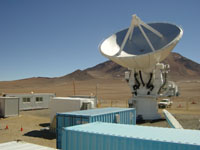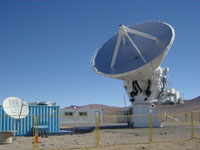



|
Located 4,800 meters above sea level at the Atacama Desert in Northern Chile, the Atacama Submillimeter Telescope Experiment (ASTE) is the state-of-the-art 10-m submillimeter telescope that observes submillimeter (0.1mm-1mm) wavelengths. ASTE has brought numerous new results by observing the center of our own galaxy, nearby star-forming regions, and distant galaxies. The extremely smooth telescope surface allows efficient submillimeter observations. The new telescope system allows astronomers to operate the telescope remotely even from Japan. The ASTE project is promoted by Natiolnal Astronomical Observatory of Japan (NAOJ), the University of Chile, and many Japanese Universities - the University of Tokyo, Hokkaido University, Nagoya University, Keio University, Osaka Prefecture University, Ibaraki University and Joetsu University of Education. The two main purposes of this project are to explore the outer space visible from the southern hemisphere in submillimeter wavelengths down to 0.3 mm, as well as to develop and evaluate observational techniques and methods suitable for submillimeter observations. Following extensive instrumental studies, ASTE has successfully begun routine astronomical observations in 2004, mainly operating at the wavelength of 0.87 mm (350 GHz). |